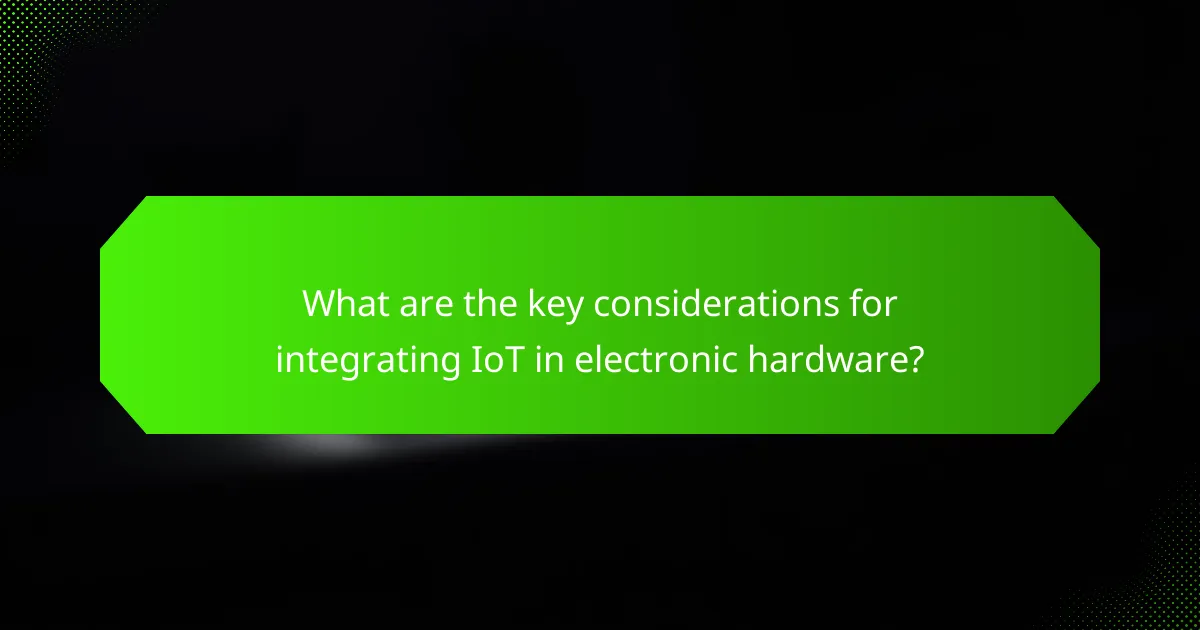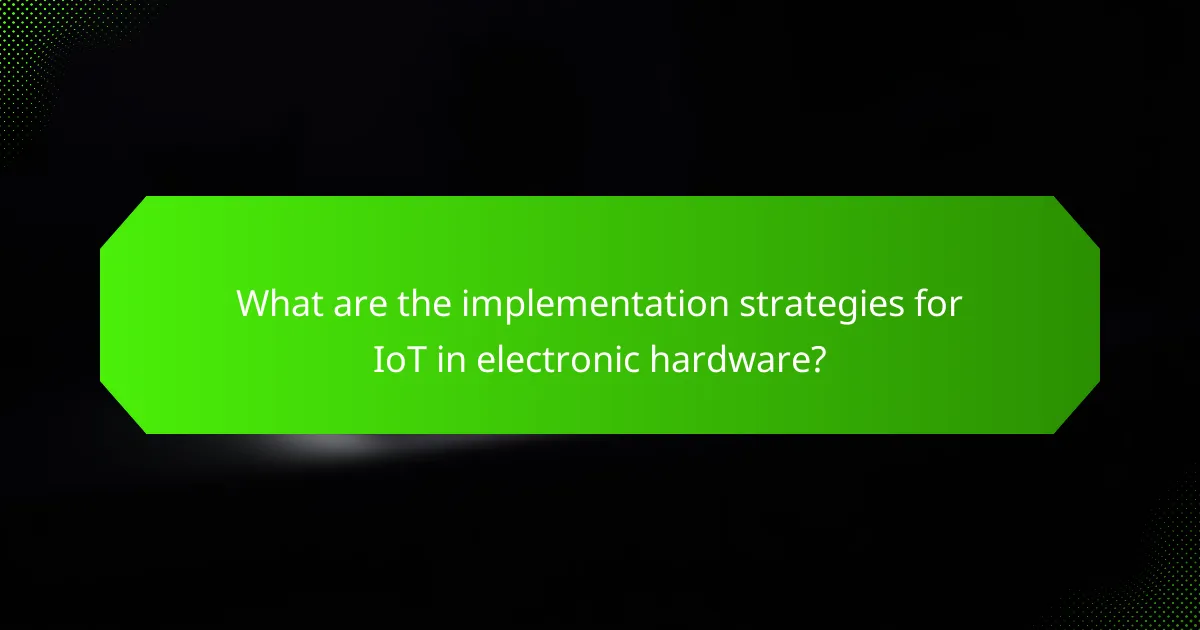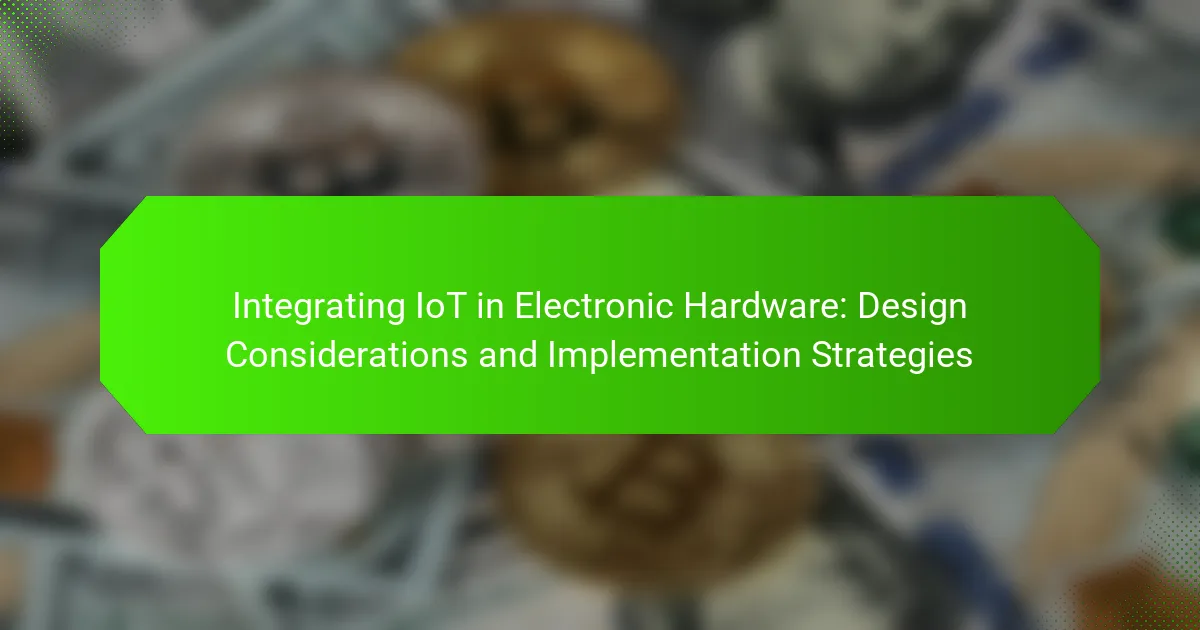The article focuses on integrating the Internet of Things (IoT) in electronic hardware, emphasizing critical considerations such as connectivity, security, power management, and scalability. It outlines implementation strategies including modular design, effective communication protocols like MQTT and CoAP, and robust security measures to ensure reliable and secure data transmission. The discussion also highlights future trends in IoT hardware integration, such as the increased use of edge computing, advanced sensor technologies, and improved interoperability standards. These factors are essential for enhancing the efficiency and effectiveness of IoT applications across various sectors, reflecting the significant growth expected in the IoT market.

What are the key considerations for integrating IoT in electronic hardware?
Key considerations for integrating IoT in electronic hardware include connectivity, security, power management, and scalability. Connectivity is crucial as devices must communicate reliably over networks. Security is essential to protect data from unauthorized access and cyber threats. Power management ensures devices operate efficiently, particularly in battery-powered applications. Scalability allows for future expansion and integration of additional devices. Each of these factors plays a vital role in successful IoT implementation in electronic hardware.
How does the design process differ when incorporating IoT technology?
The design process for electronic hardware differs significantly when incorporating IoT technology. Traditional design focuses on standalone functionality. IoT design emphasizes connectivity and data exchange between devices. This requires a shift in thinking towards network architecture and communication protocols. Designers must consider security measures to protect data transmission. Power management becomes crucial due to continuous connectivity requirements. Additionally, user experience must integrate remote access and control features. Testing and validation processes expand to include network performance and interoperability. These factors collectively redefine the design landscape in IoT-enabled hardware.
What are the essential design principles for IoT-enabled devices?
The essential design principles for IoT-enabled devices include scalability, security, interoperability, and user-centric design. Scalability ensures that devices can handle increased data and user demands over time. Security is critical to protect data and devices from unauthorized access, which has become increasingly important with the rise of cyber threats. Interoperability allows devices to communicate and work seamlessly with other systems and platforms, enhancing user experience and functionality. User-centric design focuses on creating intuitive interfaces and experiences that meet the needs of end-users effectively. These principles are supported by industry standards and best practices, ensuring that IoT devices are efficient, safe, and user-friendly.
How do hardware specifications change with IoT integration?
Hardware specifications change significantly with IoT integration. IoT devices require smaller, more efficient components. This leads to the use of low-power processors to extend battery life. Additionally, memory requirements increase due to data collection and processing needs. Connectivity options expand to include Wi-Fi, Bluetooth, and cellular technologies. Security features become essential, necessitating hardware-based encryption modules. Enhanced sensors are integrated for better data accuracy and environmental responsiveness. Overall, the shift towards IoT demands a balance between performance, power consumption, and security in hardware design.
Why is security a critical factor in IoT hardware design?
Security is a critical factor in IoT hardware design because it protects sensitive data and ensures device integrity. IoT devices often collect and transmit personal information, making them targets for cyberattacks. Without robust security measures, these devices can be compromised, leading to data breaches and unauthorized access. Research indicates that 70% of IoT devices are vulnerable to attacks due to inadequate security protocols. Furthermore, compromised devices can be used as entry points to larger networks, escalating potential damage. Effective security in IoT hardware design includes encryption, secure boot mechanisms, and regular firmware updates to mitigate these risks.
What common security threats should be addressed in IoT hardware?
Common security threats in IoT hardware include unauthorized access, data breaches, and insecure firmware. Unauthorized access occurs when attackers exploit weak passwords or default settings. Data breaches happen when sensitive information is intercepted during transmission. Insecure firmware can contain vulnerabilities that hackers can exploit. Additionally, denial of service attacks can disrupt device functionality. Malware can also infect IoT devices, compromising their integrity. According to a 2021 report by the Cybersecurity & Infrastructure Security Agency, over 70% of IoT devices are vulnerable to attacks. This highlights the importance of addressing these threats in IoT hardware design.
How can designers implement robust security measures?
Designers can implement robust security measures by integrating security features during the design phase. This includes using encryption to protect data transmission. Implementing secure boot processes ensures that only authenticated firmware runs on devices. Regular software updates help address vulnerabilities over time. Utilizing secure hardware elements, such as Trusted Platform Modules (TPMs), enhances device security. Conducting thorough threat modeling identifies potential risks early in the design process. Following industry standards, such as ISO/IEC 27001, provides a framework for establishing effective security practices. These measures collectively strengthen the overall security posture of IoT devices.
What role does connectivity play in IoT hardware integration?
Connectivity is essential for IoT hardware integration as it enables communication between devices. This communication allows data exchange, which is critical for the functionality of IoT systems. Without connectivity, devices cannot share information or respond to commands. Various connectivity options, such as Wi-Fi, Bluetooth, and cellular networks, facilitate this interaction. Each option has specific use cases based on range, power consumption, and data transfer rates. For instance, Wi-Fi is suitable for high-bandwidth applications, while Bluetooth is ideal for short-range connections. The choice of connectivity directly impacts the performance and efficiency of IoT solutions. According to a report by Statista, the number of connected IoT devices is expected to reach 75 billion by 2025, highlighting the importance of robust connectivity in this ecosystem.
What are the different connectivity options available for IoT devices?
IoT devices utilize several connectivity options to communicate effectively. Common options include Wi-Fi, Bluetooth, Zigbee, LoRaWAN, and cellular networks. Wi-Fi provides high-speed internet access and is widely used in smart home devices. Bluetooth offers short-range communication, ideal for wearable devices. Zigbee is a low-power, low-data-rate option suitable for smart home automation. LoRaWAN enables long-range communication with low power consumption, fitting for rural IoT applications. Cellular networks provide extensive coverage and are used for devices requiring constant connectivity. Each option has unique advantages, making them suitable for different IoT applications.
How does connectivity choice impact device performance and user experience?
Connectivity choice significantly impacts device performance and user experience. Different connectivity options, such as Wi-Fi, Bluetooth, and cellular, each have unique characteristics. Wi-Fi offers high-speed internet access, enhancing data transfer rates and enabling smooth streaming. Bluetooth is ideal for short-range connections, providing low power consumption and ease of pairing. Cellular connectivity allows for mobility, enabling devices to remain connected over vast distances.
The choice of connectivity can affect latency, which influences real-time applications. For example, Wi-Fi typically has lower latency compared to cellular networks. High latency can lead to delays in user interactions, negatively affecting the experience. Additionally, bandwidth limitations can restrict the amount of data transmitted, impacting performance in data-intensive applications.
Research indicates that the selected connectivity method can also influence battery life. Bluetooth, especially in low-energy mode, consumes less power than Wi-Fi, prolonging device usage. This is crucial for portable devices where battery longevity is essential. Overall, the connectivity choice directly correlates with the efficiency, responsiveness, and overall satisfaction of the user experience.

What are the implementation strategies for IoT in electronic hardware?
Implementation strategies for IoT in electronic hardware include modular design, effective communication protocols, and robust security measures. Modular design allows for flexibility and scalability in hardware components. Effective communication protocols, such as MQTT and CoAP, facilitate reliable data transmission. Robust security measures, including encryption and authentication, protect against unauthorized access. Additionally, utilizing cloud services enables data storage and analysis. Integrating edge computing reduces latency by processing data closer to the source. Continuous testing and iteration improve system reliability. These strategies are essential for successful IoT deployment in electronic hardware.
How can teams effectively collaborate on IoT hardware projects?
Teams can effectively collaborate on IoT hardware projects by utilizing structured communication and project management tools. These tools facilitate real-time updates and task assignments among team members. Regular meetings ensure alignment on project goals and timelines. Collaborative platforms like GitHub or Jira help manage code and track issues efficiently. Additionally, integrating version control systems enhances coordination on hardware designs and firmware updates. Teams should also establish clear roles and responsibilities to avoid confusion. Adopting agile methodologies can improve adaptability to changes during the project lifecycle. Finally, fostering a culture of open feedback encourages continuous improvement and innovation.
What tools and methodologies enhance collaboration in IoT development?
Collaboration in IoT development is enhanced by tools and methodologies such as Agile development, cloud platforms, and version control systems. Agile methodologies promote iterative progress and flexibility, allowing teams to adapt to changes quickly. Cloud platforms like AWS IoT and Microsoft Azure facilitate real-time data sharing and collaboration among distributed teams. Version control systems, such as Git, enable multiple developers to work simultaneously on code while tracking changes. These tools improve communication and streamline workflows, ensuring that all team members are aligned. Research shows that teams using Agile methodologies report a 25% increase in productivity compared to traditional approaches.
How can Agile practices be applied to IoT hardware projects?
Agile practices can be applied to IoT hardware projects by promoting iterative development and continuous feedback. This approach allows teams to adapt to changes quickly and efficiently. Regular sprints enable incremental progress, facilitating the integration of new features based on user feedback. Daily stand-up meetings enhance communication among team members, ensuring alignment on project goals. Prototyping is crucial in IoT, as it allows for testing hardware functionality early in the process. Agile methodologies like Scrum or Kanban can help manage tasks effectively, ensuring that hardware and software components evolve together. According to the Agile Manifesto, prioritizing customer collaboration over contract negotiation leads to better project outcomes. This principle is particularly relevant in IoT, where user requirements can change rapidly.
What testing and validation processes are necessary for IoT devices?
IoT devices require rigorous testing and validation processes to ensure functionality and security. These processes include functional testing, which verifies that the device performs its intended tasks. Connectivity testing checks the device’s ability to connect and communicate with networks. Security testing assesses vulnerabilities and ensures data protection. Performance testing evaluates response times and resource usage under various conditions. Compliance testing ensures adherence to industry standards and regulations. Usability testing assesses user experience and interface design. Field testing involves real-world scenarios to validate device performance in actual environments. Each of these testing types contributes to the reliability and safety of IoT devices.
How do testing requirements differ for IoT hardware compared to traditional devices?
Testing requirements for IoT hardware differ significantly from those for traditional devices. IoT hardware requires extensive connectivity testing due to its reliance on network communication. Traditional devices often focus primarily on functionality and durability. Security testing is also critical for IoT devices, as they are vulnerable to cyber threats. Traditional devices may not require such rigorous security evaluations. Additionally, IoT hardware must undergo interoperability testing with various platforms and protocols. This is less of a concern for traditional devices, which typically operate in isolated environments. Environmental testing is more crucial for IoT devices, as they may be deployed in diverse conditions. Overall, IoT hardware testing is more comprehensive and multifaceted compared to traditional device testing.
What are the best practices for validating IoT hardware performance?
The best practices for validating IoT hardware performance include thorough testing, monitoring, and analysis. First, conduct functional testing to ensure the hardware meets design specifications. Next, perform stress testing to evaluate performance under extreme conditions. Utilize environmental testing to assess hardware reliability in various climates. Implement continuous monitoring to track performance metrics over time. Analyze power consumption to optimize energy efficiency. Finally, gather user feedback to identify real-world performance issues. These practices help ensure the IoT hardware operates effectively and reliably in its intended environment.

What are the future trends in IoT hardware integration?
Future trends in IoT hardware integration include increased use of edge computing, advanced sensor technologies, and improved interoperability standards. Edge computing reduces latency by processing data closer to the source. This trend enhances real-time decision-making capabilities in IoT applications. Advanced sensor technologies are becoming smaller and more efficient. These sensors enable more accurate data collection and energy efficiency. Improved interoperability standards are essential for seamless communication between devices. The adoption of standards like Matter facilitates device compatibility across different ecosystems. These trends are driven by the growing demand for smart devices in various sectors. According to a report by MarketsandMarkets, the IoT market is expected to grow from $250 billion in 2020 to over $1.5 trillion by 2025, highlighting the importance of these integration trends.
How is artificial intelligence influencing IoT hardware design?
Artificial intelligence is significantly influencing IoT hardware design by enabling smarter, more efficient devices. AI algorithms allow for real-time data processing and decision-making at the edge. This reduces latency and bandwidth usage compared to cloud processing. AI enhances device autonomy, allowing IoT systems to adapt to changing conditions automatically. For instance, smart thermostats learn user preferences to optimize energy consumption. Additionally, AI-driven predictive maintenance can extend the lifespan of IoT devices by anticipating failures. According to a report by McKinsey, AI can reduce operational costs in IoT applications by up to 30%. This integration of AI into IoT hardware design leads to more responsive and intelligent systems.
What are the implications of machine learning for IoT device functionality?
Machine learning significantly enhances IoT device functionality. It enables devices to process data intelligently and make autonomous decisions. This leads to improved efficiency and responsiveness in various applications. For instance, smart thermostats learn user preferences to optimize heating and cooling. This results in energy savings and increased comfort. Additionally, machine learning algorithms can detect anomalies in device behavior. This capability enhances security and reliability. According to a report by McKinsey, machine learning can increase productivity by up to 40% in IoT systems. Thus, integrating machine learning into IoT devices transforms their operational capabilities.
How can predictive maintenance be integrated into IoT hardware?
Predictive maintenance can be integrated into IoT hardware by utilizing sensors and data analytics. Sensors collect real-time data on equipment performance and condition. This data is transmitted to a cloud platform for analysis. Advanced algorithms process the data to identify patterns and predict failures. Machine learning models can improve accuracy over time. Alerts can be generated to notify maintenance teams of potential issues. This proactive approach reduces downtime and maintenance costs. A study by McKinsey & Company found that predictive maintenance can reduce maintenance costs by 10-40%.
What are the best practices for successful IoT hardware integration?
Successful IoT hardware integration requires careful planning and execution. First, ensure compatibility between devices and protocols. This facilitates seamless communication. Second, prioritize security measures in the design phase. Implement encryption and secure authentication methods. Third, focus on scalability to accommodate future growth. This allows for easier addition of new devices. Fourth, conduct thorough testing before deployment. This helps identify and resolve potential issues. Fifth, maintain clear documentation throughout the process. This aids in troubleshooting and future upgrades. Following these practices enhances the overall effectiveness of IoT hardware integration.
How can designers ensure scalability and adaptability in IoT devices?
Designers can ensure scalability and adaptability in IoT devices by implementing modular architecture. Modular design allows components to be easily upgraded or replaced. This flexibility accommodates future technological advancements. Designers should also prioritize interoperability among devices. Using standardized communication protocols enhances compatibility across different systems. Additionally, incorporating cloud-based solutions supports data management and processing scalability. Research indicates that modular IoT systems can reduce development time by 30%. This approach allows for continuous integration of new features and functionalities. Ultimately, these strategies enable IoT devices to evolve with changing user needs and technological advancements.
What lessons can be learned from successful IoT hardware implementations?
Successful IoT hardware implementations demonstrate the importance of scalability, interoperability, and user-centric design. Scalability ensures that systems can handle increasing data loads and device connections. Interoperability allows devices from different manufacturers to communicate effectively. User-centric design focuses on creating intuitive interfaces and experiences for end-users.
These lessons are supported by case studies, such as the implementation of smart city technologies in Barcelona. The city’s IoT initiatives improved traffic management and energy efficiency. These projects highlighted the need for robust data security and privacy measures as well.
Furthermore, successful implementations often involve iterative testing and feedback loops. This approach helps identify issues early and refine functionalities. By learning from these experiences, organizations can enhance their IoT strategies and achieve better outcomes.
Integrating IoT in electronic hardware is the primary focus of this article, which outlines key considerations such as connectivity, security, power management, and scalability. The design process for IoT hardware differs from traditional methods, emphasizing the need for robust security measures and user-centric design principles. The article also explores how hardware specifications evolve with IoT integration, highlighting the importance of testing and validation processes tailored to these devices. Additionally, it discusses future trends, including edge computing and the influence of artificial intelligence on IoT functionality, providing best practices for successful implementation and collaboration in IoT projects.



